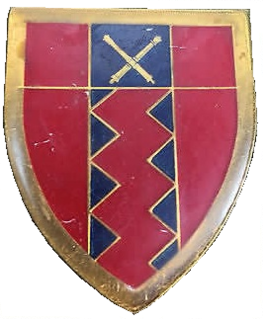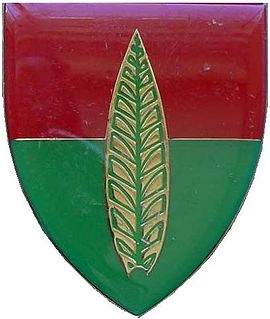
Anti-aircraft warfare, counter-air or air defence is the battlespace response to aerial warfare, defined by NATO as "all measures designed to nullify or reduce the effectiveness of hostile air action". It includes surface based, subsurface, and air-based weapon systems, associated sensor systems, command and control arrangements, and passive measures. It may be used to protect naval, ground, and air forces in any location. However, for most countries, the main effort has tended to be homeland defence. NATO refers to airborne air defence as counter-air and naval air defence as anti-aircraft warfare. Missile defence is an extension of air defence, as are initiatives to adapt air defence to the task of intercepting any projectile in flight.

The Royal Regiment of Australian Artillery, normally referred to as the Royal Australian Artillery (RAA), is a Regiment of the Australian Army descended from the original colonial artillery units prior to Australia's federation. Australia's first guns were landed from HMS Sirius and a small earthen redoubt built, near the present-day Macquarie Place, to command the approaches to Sydney Cove. The deployment of these guns represents the origins of artillery in Australia. These and subsequent defences, as well as field guns, were operated by marines and the soldiers of infantry regiments stationed in Australia. Unlike their British and Canadian equivalents, there are no regiments of horse artillery in the order of battle of the Royal Australian Artillery. The First World War saw the raising of 60 field, 20 howitzer, and two siege batteries along with the heavy and medium trench mortar batteries. Until 19 September 1962 the Australian Artillery was referred to as the 'Royal Australian Artillery', however, on this date Queen Elizabeth II granted the RAA the title of 'The Royal Regiment of Australian Artillery'. The Regiment today consists of Regular and Reserve units.

The QF 3.7-inch AA was Britain's primary heavy anti-aircraft gun during World War II. It was roughly the equivalent of the German Flak 8.8 cm and American 90 mm, but with a slightly larger calibre of 3.7 inches, approximately 94 mm. Production began in 1937 and it was used throughout World War II in all theatres except the Eastern Front. It remained in use after the war until AA guns were replaced by guided missiles beginning in 1957.

The South African Army Infantry Formation supervises all infantry within the South African Army.

The South African Army Artillery Formation is the controlling entity of all South African Army artillery units. It draws much of its history from the South African Artillery, established in 1934 but with roots that reach back to 1921. The formation consists of both regular and reserve units. There is a separate South African Army Air Defence Artillery Formation that directs army anti-aircraft warfare units.

The Sri Lanka Air Force Regiment is a specialized ground combat corps within the Sri Lanka Air Force, responsible for capturing and defending airfields and associated installations. Its members are the SLAF Regiment Officers and the airmen of operations ground specialization. The SLAF Regiment is fully capable of protecting all its air bases, installations by itself using infantry and light armored units as well as launch air assaults with Airborne Infantry elements (paratroopers). Ground-based air defense of vital military and civil installations around the country is carried out by the SLAF Regiment along with combat search and rescue missions (CSAR). The corps itself is simply known as the 'regiment'.
The Balkan Front was a military formation of the Bulgarian People's Army, intended for wartime use under the general direction of the Soviet General Staff. If a war was to have broken out between NATO and the Warsaw Pact, the bulk of the Bulgarian army would have been assigned to it.

The Hampshire Yeomanry was a yeomanry cavalry regiment formed by amalgamating older units raised between 1794 and 1803 during the French Revolutionary Wars. It served in a mounted role in the Second Boer War and World War I, and in the air defence role during and after World War II. The lineage is continued by 295 Battery and 457 Battery, batteries of 106 (Yeomanry) Regiment Royal Artillery, part of the Army Reserve.

The Regiment of Artillery is a combat/fighting arm of the Indian Army, which provides massive firepower during all ground operations of the Indian Army. It is a successor to the Royal Indian Artillery (RIA) of British Indian Army, which itself traces its origins to the formation of Bombay Artillery in 1827.

44 Parachute Brigade was a parachute infantry brigade of the South African Army. It was founded on 20 April 1978, by Colonel Jan Breytenbach, following the disbandment of 1 SA Corps and the battle of Cassinga. Upon formation, the brigade was commanded by Brigadier M. J. du Plessis, who was assigned the task of establishing by working with the Parachute Staff Officer, Colonel Jan Breytenbach. At the time du Plessis was the commanding officer of the Orange Free State Command and had previous experience serving in 1 Parachute Battalion. Breytenbach had also been a member of 1 Parachute Battalion and had also founded the South African Special Forces Brigade and 32 Battalion. The location that was chosen for the brigade's headquarters was in the lines of the OFS Cmd Headquarters, next to the old Tempe Airfield in Bloemfontein.

The Steve Biko Artillery Regiment is a airborne artillery regiment of the South African Artillery.
1st Anti-Aircraft Brigade was an Air Defence formation of the British Army, during the Second World War, and served in the Battle of France and during The Blitz. It then transferred to the Middle East, where it defended the Eighth Army's lines of communication during the final phases of the North African Campaign.
26th (London) Anti-Aircraft Brigade was an Air Defence formation of the British Army during the Second World War. It defended London during the Blitz.
28th Anti-Aircraft Brigade was an air defence formation of the British Territorial Army created in 1925 to command anti-aircraft units in Kent and around the militarily important Medway Towns, which it defended during the Second World War. In 1940 the brigade was responsible for the defences on the south side of the Thames Estuary including the Royal Naval Dockyard at Chatham and the Port of Dover. The brigade was heavily engaged throughout the Battle of Britain, in the summer of 1940, and The Blitz, from autumn 1940 to spring 1941, operating a total of 70 heavy anti-aircraft (HAA) guns controlled from a gun operations room (GOR) at Chatham. During 1942 many of the brigade's experienced units were transferred to active theatres overseas. Increasingly the brigade included women of the Auxiliary Territorial Service (ATS).

The South African Army Air Defence Artillery Formation is the controlling entity of all South African Army Air Defence Artillery units. This Formation consists of both regular and reserve units.

The Sekhukhune Anti-Aircraft Regiment is an air defence regiment of the South African Army. It is part of the South African Army Air Defence Artillery Formation. It is located in Johannesburg.

10 Anti-Aircraft Regiment is an anti-aircraft artillery regiment of the South African Army.

The 84th Heavy Anti-Aircraft Regiment, Royal Artillery was an air defence unit of Britain's Territorial Army raised from employees of the London Passenger Transport Board during the period of international tension that preceded the outbreak of World War II. During the war it served in the Norwegian Campaign and the London Blitz, and later in Tunisia and Italy.
4th Anti-Aircraft Brigade was an air defence formation of the British Army during the Second World War. It was formed just before the Battle of France to protect the British Expeditionary Force's bases. After the Dunkirk evacuation it was reformed in Egypt as a mobile formation with the Western Desert Force. It played a distinguished part in the Defence of Tobruk in 1941, but its headquarters was captured in the Fall of Tobruk the following year. It was reconstituted as a training formation in Persia and Iraq Command for the rest of the war.

15th Anti-Aircraft Brigade was an air defence formation of the Royal Artillery which saw service during the middle years of the Second World War. The brigade was formed in Gibraltar to control those anti-aircraft (AA) units based there and disbanded shortly after the air threat had been diminished in 1944. The brigade was later reformed in 1947 as part of the post-war regular army, but disbanded in 1957 following the end of the AA era.














